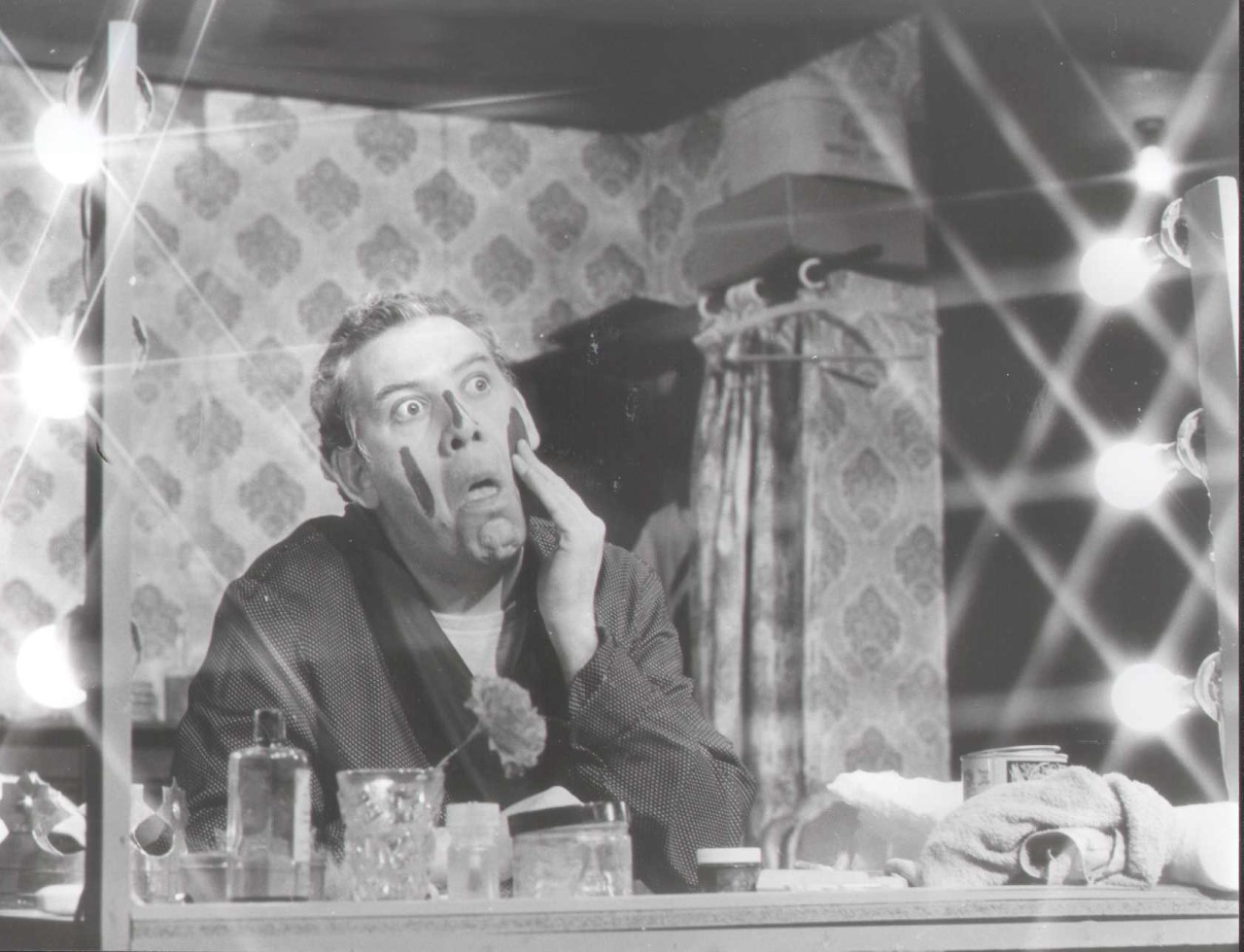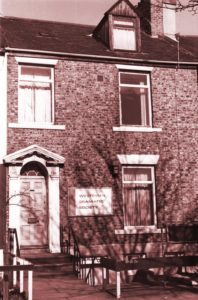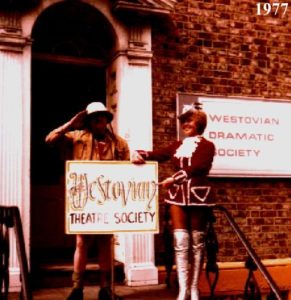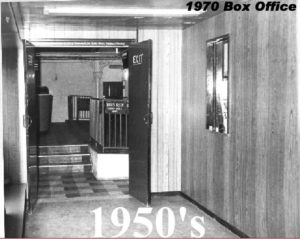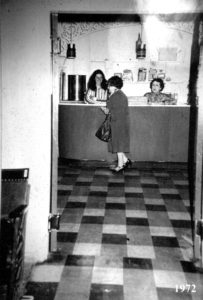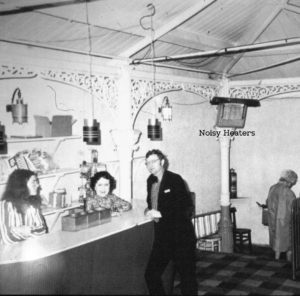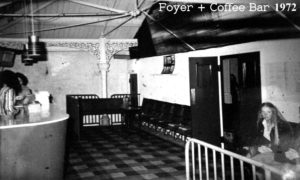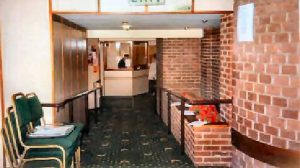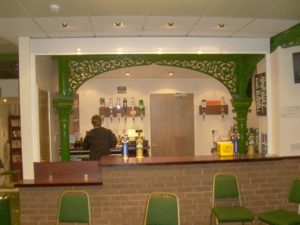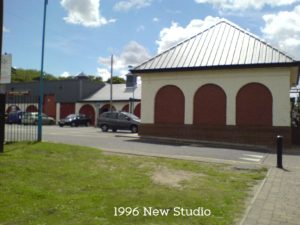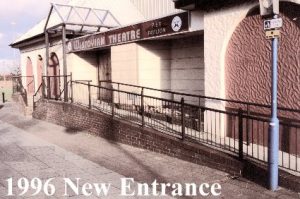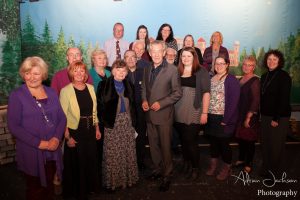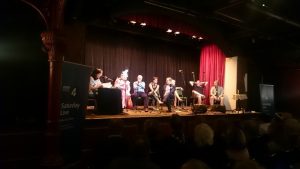Introduction
The First Thirty Years
The First Juniors
The 1950's to 1980's
The Westovian House
The Pier Pavilion
Backstage
1980 to 2010
2010 to the Present Day
The Westovian Dramatic Society was formed in October 1912 and takes their name from former ex-pupils of Westoe Secondary School.
Find below an article, which was printed in a newspaper in July 1913 to promote the Dramatic Society.
“YOU haven’t heard of the Dramatic Society? Then your education has been sadly neglected”
The Society was formed in October 1912 and consisted of a membership of seventeen. Fourteen of these were ladies and three were gentlemen. The members met every Thursday evening for rehearsal in the Secondary School. At these meetings, scenes from Shakespeare and Dickens, together with several miscellaneous sketches, were rehearsed. Naturally, we were anxious to know if we were going to have an opportunity of making our “debut”, but in due time, “engagements” came pouring in. Our first performance was on January 1913, at the Annual Dance. Two scenes from “Nicholas Nickleby” – “Fanny Squeers’ Tea Party” and “Mrs Nickleby and the Madman” – were given.
Then on January 22nd “Fanny Squeers’ Tea Party” was repeated at Queen St Church “At Home” and was very much appreciated. The third and most important function was an “At Home” given by the combined efforts of the members of this Society and the Westovian Choir, to their friends.
The Dramatic Society acted three items – “Fanny Squeers’ Tea Party” (by request), “Repairs while you Wait” and “Wanted a Lady Reader”. The Choir rendered some very pleasing items. Altogether, March 19th was a huge success, both socially and financially. The session closed with an engagement at the Seamen’s Mission on the following Monday when “Repairs while you Wait” was repeated. The success of the Society was largely due to the untiring efforts of Miss Thompson.
Before closing, I should just like to appeal to the Westovian Gentlemen and ask them to think the matter over. Come and join the Dramatic Society next Session, which will commence in September or October. One never can tell – the “Old School” may turn out another Sir Henry Irving, to say nothing of an Ellen Terry.
M. I. Main, Secretary – July 1913
In the Beginning…
Plays followed under the auspices of the English Mistress, Miss Thompson, until the end of World War I when young ladies asked to have their male friends join the Society. The expanded Society was restructured in 1918 with Annual General Meetings, play readings, casting meetings together with an expansion of membership, which not only included men but musicians, for interval interludes as well as rehearsals and productions in various halls in the town.
Many productions were staged in the Majestic Ballroom at the sea front and opposite our present home in the Westovian Theatre at the Pier Pavilion. The Majestic was a multi-purpose building with a ballroom floor which covered the old sea water baths; it had a large stage which was ideal for the Westovians in the early days. Other venues were school and church halls in various parts of the town from the older parts to the newer Cleadon estates as they developed.
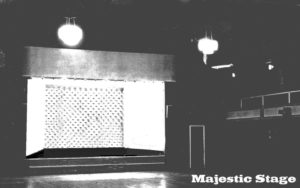
Play Readings
Up until 1939 regular Play Readings were started in the County Hotel for non-acting members which were very popular, then they went to the Dorset Café or a member’s home prior to 1950 and then, after that, they were always at Westovian House. Readings would be under the control of the Producer (now Director) and you were able to read for more than one part, if you desired, as you can now, or be asked to read a part, as the case may be. The committee would deliberate who would get which part and then a confirmed list of cast members would be circulated. Occasionally, if no-one was thought suitable for a part, a “Guest” from another society would be brought in for that production.
Backstage and Lighting
In the fifties, sixties and early seventies, sets were made up entirely of wobbly, flaky flats with the light shining through cracks, because, back in the day, we did not paper them. The flats were wood-framed and covered in canvas and even now have not all been replaced. The facilities at St Aiden’s were basic, the lighting archaic and dangerous, along with the dressing rooms being very large and located a long way down under the hall which were extremely cold. At the time, though, they seemed such an improvement on other halls used in past productions, which is why the Pier Pavilion seemed such a step up apart from the small dressing rooms. One thing that was beneficial was the amount of space at each side of the stage!
Set-building over the decades has become a more substantial task, with members sharing props and costumes for different shows. The new need to build props for specific shows, painting flats and creating new backgrounds was a mammoth task.
The lighting packs and lights have changed out of all recognition over the years as the society strives to continue improving productions. The 1977 lighting console (computerised though it was) and the sound desk was dated and have been replaced as, theatre in general and the Westovians in particular, constantly move on to more complicated productions; we strive to keep up with technology, albeit taking into account the size of the theatre, which can limit the choice of production.
Present day productions of the Westovian Dramatic Society are a far cry from the first production in the old Westoe Secondary School hall on an improvised stage with old red serge curtains, but progress has ever been the watchword and much of the present success is due to the pioneers of the past.
The stars of the first production included George Sylph, Jane Renwick, Robert Dinning and Billie Usher, then a schoolboy.
The season of 1921-22 saw the advent of Helen Charlton, Stella Newton, Winnie Parker, Ursula Reid, Doris Bain and Frank Ramsey, with Charles Hare and Harold Newton (schoolboys) pressed into service to take small parts in She Stoops to Conquer.
In the early days we gave one play per year which was rehearsed one night per week in the Westoe Secondary School.
Increased membership brought us Billie and Grace Charlton (our stage manager), Johnny Parker, Elaine Cervin, Norah Ord, George McIntyre, Norman Kemp, Ina Elles, Gilbert Collins, Madge Hunter, Helen Smedley, Reg. Smith, Gladys and Given Loman, Tom Forster, Duncan Balfour, Vera Johnson, Mabel Ellis, Bill Slee, Phillip Ward, Lander Burn, Harry D. Welch, Jean Craigie, Doris Sutton, Edith Forster and Ella Russel, Alf Golding, Washington Tate and Olga Kay.
When the British Drama League was formed we affiliated and found ourselves competing in One Act Play Festivals against such teams as the peoples Theatre, Durham Dramatic Society and the Sunderland Drama Club.
We also took part in the Newcastle Musical Tournament when medals were awarded to Helen Charlton and Lander Burn, Ella Russell and Tenerson Salkeld, Stella and Isabel Newton and Robert Dinning.
About this period we attended week-end Drama Schools at Hensham Settlement and gained practical knowledge from such well known names as Edith Craig, Margaret MacNamara and Norman Marshall. On one occasion George Sylph was awarded the prize for the mime ‘Getting into the bath’. I am sure he will still treasure the cigarette case presented by Edith Craig.
On two occasions we ventured to seek advice from professional producers and were spellbound at the technique of Charles Crabbe of Sunderland and Harry Hulbroth of the Denville Players. Incidentally, the experience gained by several of our members acting with the Denville Company proved very valuable. Some of us also enjoyed Walking on with Sir Frank Benson in Julius Caesar at the Theatre Royal in Newcastle.
Other great names of the past include Harry Morgan, Dorothy Hunter, Billie and Robert Parker, Dorothy Bradley, Alf Jones, Temple Young, Wallace Coxon, Jim Scott, Dorothea Gibbs, Freda Lambert, and Marjorie Rippon.
Between 1923 and 1946 we used to have incidental music and we remember with gratitude, Isobel Forsyth, Fred Pickering, Ronald Lamb, W. Newton Lindley, J. Parnaby, The Majestic Orchestra, The Tyne Dock Orchestra, The Westovian Ladies Orchestra, The Westoe Secondary Orchestra, The Cadet Band, Mildred Ellis and Greta Boal.
In 1939 we started regular Play Readings in the County Hotel for non acting members. These were very popular and lasted several seasons.
During the War, from 1943 to 1945, we were invited to become a unit for entertaining the troops under Northern Command. We toured with the plays ‘to Kill a Cat’, ‘Suspect’, ‘The Late Christopher Bean’ and One Act Geordie Comedies. Our team included Harry Morgan, Lorna Atkinson, Steve Webster, Norman Park, Reg Winlo, Walter Oldroyd, Lucy Grimes, Madge Hunter, Mildred Ellis, Freda Lambert, Dorothea Gibbs, George Sylph, Jim Fell, Connie Falconer and Stella Newton. We had many interesting experiences and became masters of the art of adaptation.
Our first Members Evening was started in 1945 and later our Junior Section. It is interesting to see several of our original Juniors now seasoned troupers particularly Ian Carmichael and Helen Ironside.
In 1948 Angus McGill gave us the first Poetry and Music Evening. Later he gave us our first Pantomime which has now become an annual event.
As time went on, increased membership enabled us to give several plays in the season and we came to specialise in one Tyneside Comedy per year with the old wartime team Norman Park, Helen Charlton, Stella Newton, Freda Lambert and Harry Morgan. This team has now been augmented by new and enthusiastic members.
No record of the first 30 years could be complete without expressing gratitude to the long list of regular subscribing patrons we had in our earlier years, many of whom are still ardent supporters. We remember the late Mr. And Mrs. Parker (Caterers) who gave us free use of their café in Ocean Road for rehearsals, Mrs. Sylph who allowed us to rehearse in The Havelock Inn and Mrs. Coxon who put her home at our disposal for money making Whist Drives. Mention could also be made of the successful Bridge Drives run by Helen Charlton in the Dorset Café and of our successes in winning the Helen Chapman Trophy in the South Shields Drama Festivals.
The story of the last 20 years (1948 – 1968) will tell of new names replacing most of the old, of greater concentration on lighting under the capable direction of Wilfe Clarke and the construction of more elaborate sets under the influence of Alan Knox, Douglas Dryden, The Scraftons and a willing team. This could be the theme of a future programme.
“Juniors” have actively been around since just after the war in 1945. Although there is no record of a named section as such, there is evidence that these young people took an active part in the histrionics of the Westovians from the late forties. Edna Dawson (now Lawson) is one of the remaining original “Juniors” who joined in 1946, along with a few others. They attended meetings of the Westovians in the Dorset Café, and rehearsals in the Havelock Inn and some members’ homes.
By 1950, there was an influx of juniors, introduced by word of mouth. After the war and well into the fifties, South Shields and District held a Drama Festival in association with the British Drama League for one act plays, with the juniors taking part in these festivals. From 1948 and for the next five years, they won the Helen Chapman Drama Festival Trophy at least three times.
The juniors were beginning to express themselves musically too, with two “in-house” productions in 1956 and 1957. It was the responsibility of Bob Jennings for getting such a different type of theatre off the ground.
By the end of the fifties, most of the juniors that had joined in the forties had either moved on, joined the seniors or fallen by the wayside.
The Juniors Section was formally formed in the seventies with no age range within the society. If a child was required for a play, members’ children were co-opted if they had a leaning towards theatre.
The Juniors had been left, at the beginning of the eighties, up in the air with only the pantomime for any hope of stage work, until workshops were arranged at regular meetings together with social events such as barbeques on the beach each Summer. There was a hiatus for a while until 1994 when they were started up again by a few of the older members. Since then they have had a least one production and sometimes two a year.
In the early days, one play per year was produced, rehearsing one night a week at Westoe Secondary School, then venturing to between two and four per year after the war, with an increased number of five by 1952. Most were performed in Stanhope Road School Hall as they had been from the late 1930s, with pre-show and interval music on the piano and coffee in the interval supplied by the ladies of the society; any announcements were made in front of the curtains by the House Manager.
When the British Drama League was formed, we affiliated and found ourselves competing in One Act Play Festivals against such teams as the People’s Theatre, Durham Dramatic Society and the Sunderland Drama Club.
The first Poetry and Music Evening was in 1948 by Angus McGill, who later wrote and produced our first pantomime “Cinderella” in December 1955, which has now become an annual event. Over the years, the increase in membership enabled the increase in plays per season. There also became a trend to do a “Geordie Comedy” once a year as a money-spinner.
In 1948 the Gilbert & Sullivan Society had obtained the use of St Aidan’s Hall and the Westovians came to an agreement with the G&S to use that venue for most productions starting in March 1949. Shows were then transferred totally to the Pier Pavilion in 1959.
From 1950, with the purchase of Westovian House, much time was spent by members and juniors cleaning and re-decorating as well as performing occasional productions of the time.
The first pantomime was Cinderella in January 1965 which was a re-run of Angus McGill’s earlier version.
The prime reason for undertaking pantomimes on a yearly basis was to bring in revenue to pay the bills and this is still the case. The running costs of the Society, particularly since the purchase of Westovian House, were outstripping income. This was also caused by the more professional outlook of the society at this time with better sets, not just curtain ones and hiring of costumes.
During the early seventies and up to 1977 when the Pier Pavilion was condemned, all sorts of money-making schemes were tried. At this time with thoughts of owning a theatre, the committee decided, after many past midnight meetings, that it would be a good idea to restructure the Society to help efficiency. This was undertaken by having a Production Committee with Chairman and Vice-Chairman who would serve on an Executive Committee and together with four other members could look after the productions. A Business Committee was formed to look after the fabric of the building together with the provision of facilities for productions with a Chairman and a Vice-Chairman also serving on the Executive Committee. Thus, the overall Executive Committee, comprising of four members and the officers, would ratify the Business Committee and Production Committee decisions and co-ordinate policy.
Before 1950, the society rehearsed in the Dorset Café in Ocean Road using the upstairs room and Christmas Parties were held in the Sea Hotel, along with the Havelock Inn and in private homes. Members were keen to obtain a building that could house all the things that were stored all over the town, mostly in members’ homes.
21 Beach Road was purchased for £950 as a headquarters and was renamed “Westovian House” in 1950.
1967 saw the start of alterations to the House with a Green Room Club and bar upstairs, a committee room and props/costumes room in the attic as well as redecorating the rehearsal room downstairs. After much work to get planning permission before the actual hard work could begin, the scheme came to fruition and was shown to advantage in 1968. The sixties saw the Pier Pavilion being used more and more by the Society as the number of professional shows diminished. Two members became part of the Amateur Stage Council Management Committee which liaised with the Council entertainment staff for bookings at the Pier Pavilion. This led to a lease to the Amateur Stage Council in 1972 who then ran the theatre on behalf of South Shields Council until 1975.
The building was in its original condition from 100 years earlier with all pre-war papers and varnish. The two downstairs rooms were knocked into one to provide rehearsal space; the old fireplaces were removed and gas fires were installed. The kitchen, which had originally been a breakfast room, was full of wall cupboards and was used as a kitchen to serve tea and coffee from a boiler or, if there was only a few people, a large kettle on the gas stove. There was a semi-basement from the kitchen down some steep stairs to a warren of rooms, which were originally servants’ quarters in times of “Upstairs Downstairs” but were not used as such for decades as they needed a great deal of clearing and cleaning.
A living room, which you entered from stone steps and through a door under the main steps up to the front door, corresponded in size to the front lounge upstairs. A wide corridor led to a kitchen under the dining room which had a huge black leaded range, a shallow sink and wooden draining board and a coal house off to the side. The numerous rooms and stores extended to the back of the property to what would have been a large bedroom, still with the corner fireplace in it. The basement was used as a store for flats and property and to build and decorate sets which, when finished, were transferred to St Aidan’s Hall or, in later years, the Pier Pavilion.
In about 1952 the basement to Dr Funnell. He remained there until about 1968, when Harton Estate Agency became the tenant. After Westovian House was sold, for over £20,000, the Beacon Snooker Club, The Bowler Hat Club and finally O’Briens took over the basement
There were hundreds of objects stored in the basement, perhaps thought useful for future plays. There were flats, doors, Victorian and other fireplace grates, various pieces of furniture and suites, chairs, carpets, curtains, china, pots and pans, prancing horses, urns and Grecian ladies made of iron, books and many other pieces, including at least four marble clocks standing on the mantlepiece. There was also a grandfather clock which was moved about over the years and used in various productions. Nearly all went into skips during clearances in the mid-seventies, but the grandfather clock lasted until the house was sold.
On the mezzanine floor there was a huge bathroom which still contained the iron free-standing bath, toilet and wash basin. The first floor front became the committee room which had the original fireplace along with an Edwardian table in the middle and a set of matching chairs around it. There was also a beautiful dresser with glass cupboards above which housed the Westovian scripts. The first floor side room was the wardrobe, shelved and cupboarded out, and the back room eventually became the “Junior Room”. The attic housed a lot of various trunks, wooden crates and boxes all filled with beautiful original clothes from Victorian times through to pre-war.
The cast rehearsed in the downstairs double room with the stage marked out in chalk on the floor until the weekend before a play started when everything needed was transported to the venue. The set was erected for the first time on stage at the Sunday rehearsal with the dress rehearsal on the Monday and then the show on stage. The rehearsal room was used for Junior productions, and Society meetings. It could seat up to 60 people. In 1968, planning permission was sought and alterations were made providing a rehearsal room downstairs, a Green Room and licensed bar upstairs and a costume store and committee room in the attic. Westovian House was then sold in 1981 to fund alterations to the Pier Pavilion.
The old seaside shelter in Pier Parade was converted into a small community theatre in 1948 by South Shields Corporation, at the instigation of Ald. Gompertz. This was to mitigate the loss of the Queens, which had been destroyed by bombings in 1941. The Pier Pavilion was opened on Whit Monday 1949 and, for the next few years, presented seasons of repertory and concert shows. In later years, after the Denville Players left, it was used mainly for amateur groups under the auspices of the Corporation Entertainments Committee. In 1972 the South Shields Amateur Stage Council was given the lease and, for a year or two, local societies used the facilities (sparse as they were) but it was mainly the Westovians who hired the theatre. The Amateur Stage Council gave back the lease to the Council in 1975 and in 1976 there were problems obtaining a theatre licence, as much work was needed to conform to new theatre regulations; most importantly, a fire curtain at a cost of £7,000 was needed.
In January 1977 the Westovians took a 21 year lease and installed a fire curtain. A licence was granted and it was almost “business as usual”. The Westovians were back in the Pier Pavilion just in time for the annual pantomime, however, productions were presented under difficult conditions, and other alterations had to be made. The heating system prevailed from the 1948 conversion. This was gas heaters fitted to the tops of pillars in the auditorium which gave heat at the expense of hearing the plays.
With help from the “Job Creation Scheme” and the aid of Tyne & Wear City Council and by the fundraising efforts of the members, after the July show, the theatre was gutted and all work was done by the November deadline. The Theatre re-opened in November 1977 with the production of “Who Saw Him Die?” This was made possible by members of the cast and other members spent the day before the show clearing up the builders’ mess and helped finish the decoration of the set. The show went on and the theatre now had a rated auditorium, fire curtain and a new foyer with bar and coffee bar and, very importantly, a lighting and sound box.
The Westovians were now getting settled into their new accommodation and realised that they could not financially keep both premises on and decided in 1981 to start phase two of the refurbishment. This was to renovate backstage facilities with new dressing rooms and an upper room as an extra dressing room space for pantomimes, when needed. To assist with the cost, the house in Beach Road had to be sold, except for the garage at the back of the house, which was used for storage of large props and sets.
In 1982, to reflect the change in the name of the society and the fact that the building was being hired out to other societies and organisations, the society was renamed “The Westovian Theatre Society”.
In 1996 the garage was cleared and sold to help pay for a studio/rehearsal room with adjacent workshop, new entrance and box office.
The current theatre regulations had made disabled access a priority, so a new outer ramp, together with a ramped vestibule from the box office to the foyer was built, along with a toilet large enough for wheelchair access.
The studio was designed to be the same size as the stage, and high enough to accommodate sets. Unfortunately, the builder misread the plans, and started to install the roof at only 8 foot instead of 12 foot. It was finished nearly a year later instead of the three to four months expected. In 2001, a long-awaited refurbishment of the bar meant that it moved from what now is the storage cupboard to where the entrance hall used to be, at great expense. It is now wheelchair accessible and is now an asset to the Society and the lighting system and sound board, with improved settings, have now been fitted and are extremely beneficial.
February 2008 saw the start of a new tradition, a presentation of “New Life Members to the Society”. If a person had been a member for over 50 years, then they would be eligible for a “Life Membership”. There have been many people who have been given Life Membership of the Westovians and it is hoped that this continues.
Without the help and dedication of long-standing members over the years there would not be the “Westovian Theatre Society” that there is today.
Members come and go; some stay, some come back. The Westovian Theatre Society shapes, or is part of their history. Long may it continue.
Thank you goes out to all those people who have helped put on all the wonderful productions the Westovians have done over the last 100 years, whether that be behind the scenes, front of house or on stage.
Here’s to another 100 years……
If you would like to become a member please contact us on info@westovians.co.uk
If you would like to receive our newsletter regarding forthcoming events please email news@westovians.co.uk
In the fifties, sixties and early part of the seventies sets were made up entirely of flats, wobbly, flaky flats with the light shining through cracks, because in those days we didn’t paper them. These flats were wood framed and covered in canvas and even now have not all been replaced, and not until the advent of papering sets with wallpaper were the light cracks hidden from the audiences. When Jim Gray joined the society he recalls that the set was roughly designed by the director the entrances, exits, windows and fireplaces etc. being noted and then it was up to the stage manager to sort the rest out. The original fifties back stage team comprised of, Wilf Clarke the resident electrician, very good at keeping wires in sockets with matchsticks, Alan Knox sharing stage management with Wilf, Doug Dryden and Winnie and Jimmy Scrafton the scenic set building artists and friendly but slightly ‘aloof’ from those acting, some things never change!
The facilities at St. Aidans were basic, the lighting archaic and dangerous the dressing rooms very large but a long way down under the hall and very cold. At the time though they seemed such an improvement on other halls used in past productions which is why the Pier Pavilion seemed such an improvement apart from the small Dressing Rooms, now there was space at the side of the stage!
Times change and the scenic side was taken care of by Yon Lawson, Anne Allen and Geoff Ramm and helpers. The set building now a more substantial task by Chris Allen, Neil Hales, Ken Allen, David Millar and helpers, with members sharing props and costumes for different shows.
Some things though, never change the certain ‘aloofness’ still raises it’s head from time to time and throughout all types of work involved in running a Theatre Society as in many walks of life, ‘The Willing Horse’ carries on until pensionned off or goes ‘sick’.
The lighting packs and lights have changed out of all recognition over the years and as the society strives to continue improving productions. Looking back the present facilities would have been marvellous to those older members in the fifties. Yet in 1977 when the first phase of building was done and only back stage was slightly spruced up, these facilities seemed quite good and after the 1981 phase when the Dressing Rooms were enlarged and fitted out, consensus was the improvement was staggering. Now as the Millennium beckoned they seem small, tacky and in great need of renovation. This just shows how far the society has come in the last 80 years or so.
Even after the 1996 extensions with a rehearsal studio, workshop etc. storage is still at a premium there seems to be no space at the side of the stage, we cannot fly sets and set pieces wouldn’t it be nice to have more space? or a Fly Tower. Though I have to say that ‘Political Correctness’ seems to be going mad when you now have to have four foot wide gantries and a lift so that wheel chair persons can be accomodated to work backstage.
The lighting console, computerised though it was and the Sound Desk, both of which would have gladenned Wilf Clarke’s and his predecessors hearts now seemed dated. So as theatre in general and the Westovians in particular constantly move on to more complicated productions and we strive to keep up, we renewed our Lighting and Sound Systems in 2005. So it is the size of our theatre. which now limits the choice of production material.
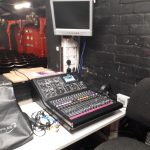
The Second Phase in 1981 gave us better backstage facilities, even if they now seem antiquated. The Society pushed for extensions in the early 1990s and the studio opened in1996 together with the new entrance, workshop and disabled facilities and have been seen as an asset.
During this time there were many notable social events, fancy dress, beetle drives, treasure hunts as well as the established annual carol night and annual dinner dances, which are still ongoing to this day.
Mention must be made of the annual barbeques and cricket matches, along with fundraising events including bingo, blind cards, darts matches and jumble sales.
The greatest change from those early years is the amount of work now needed to support amateurs in their presentation of productions in a professional manner. The need for directors and actors to present eight shows per year certainly makes much work for the Production Committee.
Having our own theatre has shown the need for the Business Committee, not only in keeping the building in good repair, but also providing more modern facilities for those acting in the shows. What we need for the next century are more members to carry on the work of their predecessors to keep the productions rolling for another 100 years.
The 287 seat theatre inside its visual delight, full of character, with plush red 1930’s style tip-up seats laid out between original old cast iron columns and fretted iron cast arch sprandels.
There have been a host of comedies and farce to dramas and mysteries, however the annual pantomime is a firm favourite for people.
The Westovian Theatre Society has hosted the likes of Chris Ramsey, Sir Ian McKellan, BBC 4 Radio Live and various other comedians and groups.
We also have repeat bookings, such as U3A, “University of the Third Age” an organisation for retired people; Youth Groups (David Ducasse); various singing groups (Encore); other amateur societies; professionals (Chris Ramsey); various musicians; tribute bands (Blue Flamingos) and visiting plays.
Along with the hiring’s, we have a season packed full of family fun, dramas, plays and pantomimes.
The Westovian Theatre Society is a leading Amateur group in South Tyneside.

